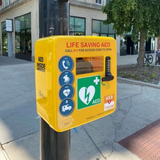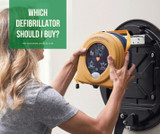Learn how to save a life - Defibrillators
Defibrillators are emergency medical tools that allow anyone who is nearby to deliver life saving care when someone falls ill due to a sudden cardiac arrest (SCA). When a SCA occurs you need to act very quickly as they are caused by a problem with the heart’s electrical rhythm meaning a victims heartbeat is not beating at it’s usual pace.
People who are suffering from a SCA will fall unconscious and their breathing will have either stopped or will be irregular. To help someone who is suffering fro a SCA, you must first raise the alarm by calling 999, begin delivering CPR and then use a defibrillator if one is nearby. Defibrillators greatly increase the chance of survival with every minute improving a victims survival rate drastically.
Defibrillators work by delivering an electric shock to the heart in order to return it to it’s natural rhythm. Although this sounds like something that a medical professional such as a paramedic, nurse or doctor would perform, defibrillators are specifically designed to be used by anyone.
With ease of use at the forefront of their manufacturing, defibrillators are equipped with lots of helpful tools to guide the user through the process. With verbal instructions, visual guides and lights on most defibrillators anyone can use one.
Defibrillators can be found in a number of locations. They are increasingly being installed at sports grounds such as football and rugby pitches across the country as well as shops, schools, offices, factories and public buildings. The most defibrillators that are installed, the more chance of delivering emergency medical care should anyone ever fall ill due to a SCA.
Defibrillators that are stored in public areas such as in a secure case outside a building are known as public access defibrillators (PADs) and can be accessed by anyone. Often they require a code to open them which can be easily obtained by ringing the emergency services.
With the ambulance service attempting resuscitation an average 30,000 times a year and one in ten of these happening in hospital, the chance of someone suffering from a SCA in a public environment are much higher than when someone is in the care of medical staff. This means that the more people that are educated and know about defibrillators the better as there is a higher chance they can deliver effective emergency care.
Recent Posts
-
Empowering Communities: The Lifesaving Impact of CPR on Restart a Heart Day
Every year, on and around October 16th, an important event takes place - Restart a Heart Day. This a …16th Oct 2023 -
Which home defibrillator?
80% of all out of hospital cardiac arrests occur at home. Defibrillators are often available in loca …4th Dec 2022 -
Which defibrillator should I buy?
There are many defibrillators available on the market and it can become overwhelming knowing which o …4th Nov 2022




